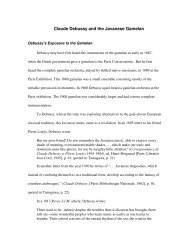Music Preference 1 - Brent Hugh's personal and business web pages
Music Preference 1 - Brent Hugh's personal and business web pages
Music Preference 1 - Brent Hugh's personal and business web pages
Create successful ePaper yourself
Turn your PDF publications into a flip-book with our unique Google optimized e-Paper software.
<strong>Music</strong> <strong>Preference</strong> 47<br />
Question 4: Do recital audiences <strong>and</strong> school audiences of a similar age have a different response<br />
Results<br />
to the informational presentations?<br />
Responses to treatments N <strong>and</strong> ID were compared for (a) the subgroup of recital audiences<br />
under age 1-20 <strong>and</strong> (b) school groups (LE, UE, MS, <strong>and</strong> HS), which represent approximately the<br />
same age range. Analysis of variance with repeated measures showed that, in this age group,<br />
recital audiences responded to the treatments in a significantly different way than did school<br />
groups (see Table 14). For recital audiences under age 20, the difference in mean ratings due to<br />
the treatments is 0.30 (7.5%) <strong>and</strong> for school audiences the difference is 0.07 (1.8%; see Table 11<br />
<strong>and</strong> Table 13).<br />
Discussion<br />
The result of this question establishes even more strongly the difference between the<br />
responses of the school groups <strong>and</strong> the recital audience. The preference ratings of recital<br />
audiences are influenced far more by informational introductions than are preference ratings of<br />
school audiences. This finding lends support to the idea that different models of attitude change<br />
apply to these different groups.<br />
The question of why the two groups are so different in their response is difficult to answer<br />
precisely. The recital audience volunteered to attend the concert <strong>and</strong> so presumably has a high<br />
interest in the type of music played <strong>and</strong> a high interest in finding self-justification for the<br />
decision to spend time attending the concert. This may partly explain the higher average<br />
preference ratings (regardless of treatment) given by group RA1 in comparison to the ratings<br />
given by the school groups. However, with the latin-square experimental design, this<br />
confounding variable should have no bearing on effects found for treatments <strong>and</strong> so does not, by





